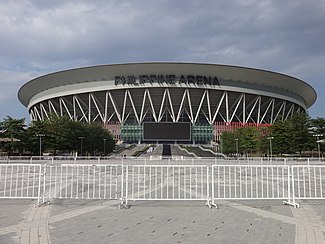Philippine Arena
 | |
 | |
 | |
| Location | Ciudad de Victoria, Bocaue, Bulacan, Philippines[note 1] |
|---|---|
| Coordinates | 14°47′46″N 120°57′16″E / 14.79611°N 120.95444°E (roof) |
| Owner | New Era University (Iglesia ni Cristo) |
| Operator | Maligaya Development Corporation |
| Record attendance | 55,000[2] (Eat Bulaga!: Sa Tamang Panahon, October 24, 2015) |
| Field size | 220 m × 170 m (720 ft × 560 ft)[3] |
Building details | |
 | |
| General information | |
| Architectural style | Modernist |
| Groundbreaking | August 17, 2011 |
| Completed | May 30, 2014 |
| Inaugurated | July 21, 2014 |
| Cost | US$213 million[4] (₱9.4 billion)[5] |
| Height | 65 m (213 ft)[3] |
| Dimensions | |
| Diameter | 227 m × 179 m (745 ft × 587 ft) |
| Technical details | |
| Floor count | 4 |
| Grounds | 36,443.6 m2 (392,276 sq ft)[3] |
| Design and construction | |
| Architecture firm | Populous |
| Developer | New San Jose Builders |
| Structural engineer | Buro Happold |
| Main contractor | Hanwha Engineering and Construction[6] |
| Other information | |
| Seating capacity | 55,000[7] |
| Website | |
| philippinearena.net | |
The Philippine Arena is the world's largest indoor arena.[8] It is a multipurpose indoor arena with a maximum seating capacity of 55,000 at Ciudad de Victoria, a 140-hectare tourism enterprise zone in Bocaue and Santa Maria, Bulacan, Philippines[9] about 30 kilometers north of Manila. It is one of the centerpieces of the many centennial projects[10] of the Iglesia ni Cristo (INC) for their centennial celebration on July 27, 2014.[11] The legal owner of the arena is the INC's educational institution, New Era University.[12]
History
Construction
In 2011, Korean firm, Hanwha Engineering and Construction won the contract to manage the construction of the Philippine Arena. Hanwha outbested bids from Filipino firm, EEI Corporation an done on August 17, 2011.[13] Hanwha announced that it had completed the construction of the indoor arena on May 30, 2014.[8] The venue was not formally inaugurated until almost two months later.
Inauguration
The Philippine Arena, along with Ciudad de Victoria was officially inaugurated on July 21, 2014. Then-Philippine President Benigno Aquino III and Iglesia ni Cristo Executive Minister Eduardo Manalo unveiled the marker of Ciudad de Victoria.[14]
Building details
Concept
The initial design concept of the Philippine arena is inspired by the narra tree, the mother tree of the Philippines, and the root of the banyan tree.[15] The roof was inspired by that of a Nipa Hut.[16]
Architecture
Populous, a global mega-architecture firm, designed the arena through their office in Brisbane, Australia.[17] The official website of the sports facility describe's the structure's architectural style as Modernist.[18]The arena has been master planned to enable at least 50,000 people to gather inside the building and a further 50,000 to gather at a ‘live site’ or plaza outside to share in major events.[17] The seating bowl of the arena is a one-sided bowl and is partitioned into two parts, the upper and the lower bowl each with approximately 25,000 seating capacity. The lower bowl is the most used part of the building and the architectural design allows for easy separation of the lower bowl from the upper tier, by curtaining with acoustic and thermal properties. A retractable seating of 2,000 people capacity is also installed behind the stage which is used by the choir of the Iglesia ni Cristo for events of the church.[3]
The seating layout of the arena is different from that of a standard arena where the stage is at the middle and is surrounded by seats. The seating of the arena closely resembles that of a Greek amphitheater, built in a semi-circle with the seats at the sides and front of the arena stage. The seatings are divided into three sections. Each of the sections are colored green, white and red: the colors of the Iglesia ni Cristo flag.[19]
The arena has 4 floors or levels. Level 1 is the stage level, Level 2 is the main access level open to the general viewing public, Level 3 is the VIP area which also houses conference rooms with views facing the main plaza outside the indoor arena building and Level 4 is the upper concourse.[3]
Furthermore, contractor Hanwha hired their own architecture firm, Haeanh Architects for the project.[3]
Structure
Built on 99,200 square meters (1,068,000 sq ft) square meters of land, the arena has a dome over 9,000 square meters (97,000 sq ft).[20] The oval roof has a dimension of 227 m × 179 m (745 ft × 587 ft)[21] and contains 9,000 tons of steel work. The roof was made as a separate unit to reduce burden on the arena with extra load. The arena is 65 meters (213 ft) in height, or about fifteen stories high and founded on pile construction. About a third of the dead load of the building was designed for earthquake loads. The building was also divided into multiple structures to strengthen the arena's earthquake resistance.[16][22]
Landscape
PWP Landscape Architecture, the firm who landscaped the National September 11 Memorial & Museum,[23] designed the landscape for the arena and the whole complex of Ciudad de Victoria. For the arena, a series of outdoor plazas, gardens and performance venues form the setting for the development including: The North and South Arrival Plazas, The Promontory Plaza, The Great Stairs, and Ciudad de Victoria Plaza that are all related to each other with two cross axes (N-S and E-W) that intersect at the Promontory Plaza. Two fountains that can shoot waters up to 15 meters (49 ft) are also installed in front of the arena.[12]
Uses


The arena holds not only major church gatherings of the Iglesia ni Cristo, but also operates as a multi-use sports and concert venue, capable of holding a range of events from boxing and basketball to live music performances, but no association football or field events due to its limited size. There is clear "line of sight" for every seat from each tier, even for various arena configurations such as church ceremonies, boxing, tennis, concerts or indoor gymnastics. The Iglesia ni Cristo allows non-Iglesia tenants to use the arena. The church reserves the right to disallow activities which it sees violate its religious principles, which include gambling-related events and cockfighting.[17][24][25]
Notable events
In popular media
The Philippine Arena was featured in a documentary called Man Made Marvels: Quake Proof. It aired on December 25, 2013, on Discovery Channel and focused on making structures in the Philippines more safe from natural disasters in general such as earthquake and typhoons.[26]
Reception
On July 27, 2014, Guinness World Records recognized the arena as the largest mixed-use indoor theater.[27]
Notes
See also
References
- ^ "Contact". Philippine Arena. Archived from the original on 19 July 2018. Retrieved 19 December 2016.
The Philippine Arena
• Ciudad De Victoria, Bocaue Bulacan, Philippines - ^ "AlDub shatters records anew". philstar.com. Retrieved 2015-10-24.
- ^ a b c d e f Pan Stadia & Arena Management (Autumn 2014 ed.). 24–26 September 2014. pp. 85–87.
- ^ Newcomb, Tim (August 31, 2011). "Building Bigger: World's Largest Indoor Arena Set for the Philippines". Time. Retrieved July 8, 2013.
- ^ Encarnacion, Fidea (July 24, 2014). "INFOGRAPHICS: The Philippine Arena vs. world stadiums". ABS-CBNNews.com. Retrieved July 24, 2014.
- ^ Choi, He-suk (August 18, 2011). "Hanwha E&C to build world's largest domed arena near Manila". The Korea Herald. Retrieved July 8, 2013.
- ^ "Facilities – The Philippine Arena". philippinearena.net. Retrieved 17 April 2017.
- ^ a b de Vera, Ben (11 June 2014). "Korean construction firm completes Iglesia ni Cristo's P7-B Philippine Arena". Philippine Daily Inquirer. Retrieved 22 September 2016.
- ^ Donna, Cueto-Ibanez (July 20, 2014). "Iglesia opens world's largest indoor arena for centennial rites". Philippine Daily Inquirer. Retrieved July 20, 2014.
- ^ Salud, Joel Pablo (November 5, 2012). Joel Pablo Salud (ed.). "Dawn of the New Guard". Philippine Graphic (magazine)
|format=requires|url=(help). Makati City, Philippines: T. Anthony C. Cabangon. 23 (23): 23. OCLC 53164818. - ^ "Populous Designs World's Largest Arena in Manila in the Philippines". Populous. August 29, 2011. Retrieved July 8, 2013.
- ^ a b "New Era University Philippine Arena". PWP Landscape Architecture. Retrieved July 8, 2013.
- ^ Ranada, Pia (July 27, 2013). "Waiting for Iglesia ni Cristo's PH Arena". Rappler. Retrieved July 29, 2014.
- ^ Locsin, Joel (July 21, 2014). "PNoy arrives at Philippine Arena in Bulacan for Iglesia ni Cristo event". GMA News. Retrieved July 24, 2014.
- ^ "Philippine Arena". Haeahn Architecture. Archived from the original on August 19, 2013. Retrieved August 19, 2013.
- ^ a b Arcangel, Xianne (July 21, 2014). "INC's Philippine Arena a 'challenge' for firm behind London's O2". GMA News. Retrieved July 23, 2014.
- ^ a b c "New Manila Arena pushes boundaries of Arena Design". Populous. Archived from the original on May 13, 2013. Retrieved July 8, 2013.
- ^ "About – Architecture". Philippine Arena. Retrieved 14 December 2017.
- ^ Santos, Reynaldo Jr. (July 21, 2014). "FAST FACTS: Iglesia ni Cristo's Philippine Arena". Rappler. Retrieved July 24, 2014.
- ^ Ramon Efren R. Lazaro (February 13, 2013). "Prices of agriculture lands in Bulacan town rise". Business Mirror. Archived from the original on December 1, 2013. Retrieved July 16, 2013.
- ^ Kim, Jong-soo; Cho, Duck-won; Choi, Eun-gyu; Cho, Hyun-wook (2015). "Structural health monitoring during construction in Philippine Arena". Proceedings of the International Association for Shell and Spatial Structures (IASS) Symposium 2015.
- ^ Peter Hipolito (September 11, 2011). "Chris Sparrow on the Groundbreaking of the Philippine Arena 04:30". Christian Era Broadcasting Services Inc. YouTube. Retrieved July 8, 2013.
- ^ "National 9/11 Memorial". PWP Landscape Architecture. Retrieved July 8, 2013.
- ^ June Navarro (April 22, 2013). "POC eyes INC-owned stadium as training site". Philippine Daily Inquirer. Retrieved July 16, 2013.
- ^ Badua, Snow (April 18, 2014). "Noticed that huge arena while travelling down NLEX during Holy Week? Well, it's months away from grand opening". Sports Interactive Network Philippines. Retrieved July 24, 2014.
- ^ Umbao, Ed (December 27, 2013). "INC's Philippine Arena Featured on Discovery Channel (Video)". Philippine News. Retrieved December 31, 2013.
- ^ "Largest Mixed-Use Indoor Theatre". GuinnessWorldRecords.com. Guinness World Records. Retrieved October 1, 2014.
External links
![]() Media related to Philippine Arena at Wikimedia Commons
Media related to Philippine Arena at Wikimedia Commons
| Events and tenants | ||
|---|---|---|
| Preceded by Wukesong Arena
Beijing |
FIBA World Cup Final venue 2023 |
Succeeded by TBD
|
- Indoor arenas in the Philippines
- Iglesia ni Cristo
- Basketball venues in the Philippines
- Buildings and structures in Bulacan
- Sports in Bulacan
- Sports venues completed in 2014
- 2014 establishments in the Philippines
- Modernist architecture in the Philippines


